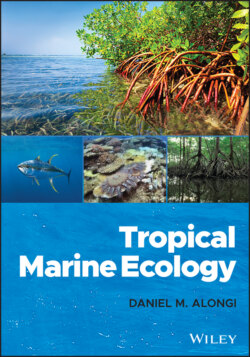Читать книгу Tropical Marine Ecology - Daniel M. Alongi - Страница 27
На сайте Литреса книга снята с продажи.
2.7.3 Rising Temperatures, Increased Storms, Extreme Weather Events, and Changes in Precipitation
ОглавлениеThe rate of ocean heating has increased within the 0–700 m layer by 3.22 ± 1.61 ZJ (ZJ = 1021 joules) from 1969 to 1993 and 6.28 ± 0.48 ZJ from 1993 to 2017, representing a twofold increase in heat uptake (Bindoff et al. 2019). This has resulted in temperature rises as noted earlier. Warming has also strengthened vertical stratification, inhibiting exchange between surface and deep ocean waters. Redistribution of heat accounts for 65% of heat storage at low latitudes. Tropical warming results from the interplay between increased stratification and equatorward heat transport by the subtropical gyres, which redistributes heat from the subtropics to the tropics (Dias et al. 2020).
Projections (Bindoff et al. 2019) are that by 2100 the ocean is very likely to warm by 2–4 times as much for low emissions (IPCC scenario RCP2.6) and 5–7 times as much for the IPCC's ‘business‐as‐usual’ scenario (RCP8.5) compared with the observed changes since 1970. The top 200 m of the upper ocean will continue to stratify to 2100 in the very likely range of 1–9% and 12–30% for scenarios RCP2.6 and RCP8.5, respectively.
Projections of future precipitation (Table 2.1) in the tropics indicate widely variable changes with regions. Rainfall is forecast to decline in northern South America, the Caribbean and western Central America, South Asia, and northern and eastern Australia. Increased precipitation is expected in all other tropical areas, except in the Arabian Sea where little change is expected. Much of these forecasted changes are linked to forecasted changes in the intensity and frequency of tropical cyclones (Knutson et al. 2020). There is at least medium‐to‐high confidence in an increase globally in tropical cyclone precipitation, with a median projected increase of 14% or close to the rate of tropical water valour increase with warming, at constant relative humidity (Knutson et al. 2020); cyclone intensity will increase with medium‐to‐high confidence. Knutson et al. (2020) indicate that expert opinion was more mixed and confidence levels lower for (i) a further poleward expansion of the latitude of maximum cyclone intensity in the western North Pacific; (ii) a decrease in global tropical cyclone frequency; and (iii) an increase in very intense global tropical cyclone frequency (category 4–5). These changes in tropical precipitation are linked to changes in surface land‐ocean temperature and changes in near‐surface relative humidity (Lambert et al. 2017). High precipitation under climate change is associated with the highest surface relative humidity and temperatures.
TABLE 2.1 IPCC projected changes for tropical regions in salinity, precipitation, and sea‐level rise for 2081–2100 (relative to the 1986–2005 reference period).
Source: Church et al. (2013), Collins et al. (2013), Bindoff et al. (2019) and Oppenheimer et al. (2019). © John Wiley & Sons.
| Region | Salinity a | Precipitation b | Sea‐level rise c |
|---|---|---|---|
| N. South America | 0 to 5 ↑ | −10 to 40% ↓ | 0.22 to 0.24 m |
| E. South America | 0 to 5 ↑ | 0 to 10% ↑ | 0.18 to 0.20 m |
| Caribbean and W. Central America | 0.5 to 1.0 ↑ | −20 to 10% ↓ | 0.18 to 0.20 m |
| Central West Africa | 0 to 1.5 ↓ | 10 to 20% ↑ | 0.20 to 0.24 m |
| Central East Africa | 0 to 2.0 ↓ | 10 to 50% ↑ | 0.20 to 0.24 m |
| Red Sea/Arabian Peninsula | No change | −10 to 10% ↔ | 0.22 to 0.24 m |
| South Asia | 0 to 5 ↑ | −40 to 10% ↓ | 0.18 to 0.24 m |
| SE Asia | 0 to 1.0 ↓ | 0 to 20% ↑ | 0.18 to 0.20 m |
| N. Australia | No change | 0 to 10% ↓ | 0.18 to 0.20 m |
| E. Australia | No change | −10 to 0% ↓ | 0.18 to 0.20 m |
| Oceania | No change | 0 to 10% ↑ | 0.18 to 0.22 m |
a Range of projected sea surface salinity changes for 2081–2100 relative to the 1986–2005 reference period.
b Range of projected changes in December to February precipitation for 2081–2100 relative to 1986–2005. Data from Collins et al. (2013).
c Range of ensemble mean projections of the time‐averaged dynamic and steric sea‐level changes for the period 2081–2100 relative to 1986–2005. Data from Church et al. (2013) and Oppenheimer et al. (2019).
